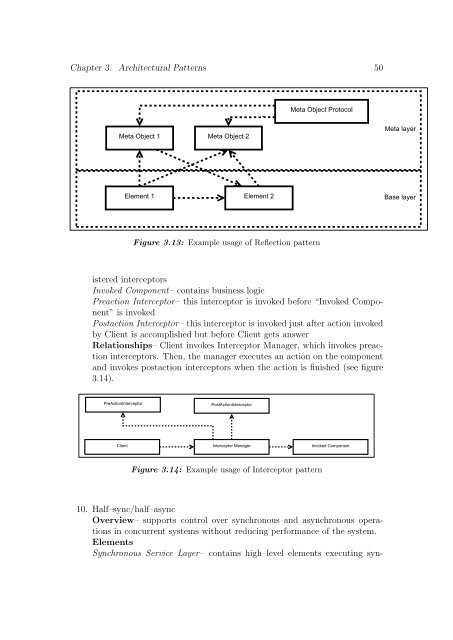Migration of a Chosen Architectural Pattern to Service Oriented ...
Migration of a Chosen Architectural Pattern to Service Oriented ... Migration of a Chosen Architectural Pattern to Service Oriented ...
Chapter 3. Architectural Patterns 50Meta Object ProtocolMeta Object 1Meta Object 2Meta layerElement 1 Element 2Base layerFigure 3.13: Example usage of Reflection patternistered interceptorsInvoked Component– contains business logicPreaction Interceptor– this interceptor is invoked before “Invoked Component”is invokedPostaction Interceptor– this interceptor is invoked just after action invokedby Client is accomplished but before Client gets answerRelationships– Client invokes Interceptor Manager, which invokes preactioninterceptors. Then, the manager executes an action on the componentand invokes postaction interceptors when the action is finished (see figure3.14).PreActionInterceptorPostActionInterceptorClientInterceptor ManagerInvoked ComponentFigure 3.14: Example usage of Interceptor pattern10. Half–sync/half–asyncOverview– supports control over synchronous and asynchronous operationsin concurrent systems without reducing performance of the system.ElementsSynchronous Service Layer– contains high–level elements executing syn-
Chapter 3. Architectural Patterns 51chronous logic of the systemSynchronous Service– represents logic of the system executed in a synchronousmannerAsynchronous Service Layer– contain low–level elements executing asynchronouslogic of the systemAsynchronous Service– represents logic of the system executed in an asynchronousmannerQueueing Layer– contains element mediating between Synchronous andAsynchronous layersQueue– a mediating element from Queueing LayerExternal Event Source– generates event processed by services from AsynchronousLayerRelationships– - Services from each layer can cooperate with other servicesfrom the same layer. They can also invoke Queue that serves as a messagestore. External Data Source can invoke only services from AsynchronousLayer (see figure 3.15 ).Sync Service 1 Sync Service 2 Sync Service 3 Synchronous Service LayerQueueQueueing LayerAsync Service 1Asynchronous Service LayerExternal Event SourceFigure 3.15: Example usage of Half–Sync Half–Async pattern11. Shared RepositoryOverview– provides solution for problem of passing large amount of databetween elements of a system. The pattern reduces additional overhead andperformance drop.ElementsRepository – is a core element of the pattern. It is meant to store, maintain
- Page 9 and 10: 3.3.1 Definition of Pattern Languag
- Page 11 and 12: Chapter 1Introduction1.1 Background
- Page 13 and 14: Chapter 1. Introduction 3technique
- Page 15 and 16: Chapter 1. Introduction 5was notice
- Page 17 and 18: Chapter 1. Introduction 7do not pro
- Page 19 and 20: Chapter 1. Introduction 9Chapter 4
- Page 21 and 22: Chapter 2. Related Work 11This chap
- Page 23 and 24: Chapter 2. Related Work 13(b) Chara
- Page 25 and 26: Chapter 2. Related Work 15Figure 2.
- Page 27 and 28: Chapter 2. Related Work 17Drawbacks
- Page 29 and 30: Chapter 2. Related Work 19Figure 2.
- Page 31 and 32: Chapter 2. Related Work 21Advantage
- Page 33 and 34: Chapter 2. Related Work 23between a
- Page 35 and 36: Chapter 2. Related Work 252. Applic
- Page 37 and 38: Chapter 2. Related Work 274. Mediat
- Page 39 and 40: Chapter 2. Related Work 292.3 Summa
- Page 41 and 42: Chapter 3. Architectural Patterns 3
- Page 43 and 44: Chapter 3. Architectural Patterns 3
- Page 45 and 46: Chapter 3. Architectural Patterns 3
- Page 47 and 48: Chapter 3. Architectural Patterns 3
- Page 49 and 50: Chapter 3. Architectural Patterns 3
- Page 51 and 52: Chapter 3. Architectural Patterns 4
- Page 53 and 54: Chapter 3. Architectural Patterns 4
- Page 55 and 56: Chapter 3. Architectural Patterns 4
- Page 57 and 58: Chapter 3. Architectural Patterns 4
- Page 59: Chapter 3. Architectural Patterns 4
- Page 63 and 64: Chapter 3. Architectural Patterns 5
- Page 65 and 66: Chapter 3. Architectural Patterns 5
- Page 67 and 68: Chapter 3. Architectural Patterns 5
- Page 69 and 70: Chapter 3. Architectural Patterns 5
- Page 71 and 72: Chapter 3. Architectural Patterns 6
- Page 73 and 74: Chapter 3. Architectural Patterns 6
- Page 75 and 76: Chapter 3. Architectural Patterns 6
- Page 77 and 78: Chapter 3. Architectural Patterns 6
- Page 79 and 80: Chapter 3. Architectural Patterns 6
- Page 81 and 82: Chapter 3. Architectural Patterns 7
- Page 83 and 84: Chapter 3. Architectural Patterns 7
- Page 85 and 86: Chapter 4. Service Oriented Archite
- Page 87 and 88: Chapter 4. Service Oriented Archite
- Page 89 and 90: Chapter 4. Service Oriented Archite
- Page 91 and 92: Chapter 4. Service Oriented Archite
- Page 93 and 94: Chapter 4. Service Oriented Archite
- Page 95 and 96: Chapter 4. Service Oriented Archite
- Page 97 and 98: Chapter 4. Service Oriented Archite
- Page 99 and 100: Chapter 4. Service Oriented Archite
- Page 101 and 102: Chapter 4. Service Oriented Archite
- Page 103 and 104: Chapter 4. Service Oriented Archite
- Page 105 and 106: Chapter 4. Service Oriented Archite
- Page 107 and 108: Chapter 4. Service Oriented Archite
- Page 109 and 110: Chapter 4. Service Oriented Archite
Chapter 3. <strong>Architectural</strong> <strong>Pattern</strong>s 50Meta Object Pro<strong>to</strong>colMeta Object 1Meta Object 2Meta layerElement 1 Element 2Base layerFigure 3.13: Example usage <strong>of</strong> Reflection patternistered intercep<strong>to</strong>rsInvoked Component– contains business logicPreaction Intercep<strong>to</strong>r– this intercep<strong>to</strong>r is invoked before “Invoked Component”is invokedPostaction Intercep<strong>to</strong>r– this intercep<strong>to</strong>r is invoked just after action invokedby Client is accomplished but before Client gets answerRelationships– Client invokes Intercep<strong>to</strong>r Manager, which invokes preactionintercep<strong>to</strong>rs. Then, the manager executes an action on the componentand invokes postaction intercep<strong>to</strong>rs when the action is finished (see figure3.14).PreActionIntercep<strong>to</strong>rPostActionIntercep<strong>to</strong>rClientIntercep<strong>to</strong>r ManagerInvoked ComponentFigure 3.14: Example usage <strong>of</strong> Intercep<strong>to</strong>r pattern10. Half–sync/half–asyncOverview– supports control over synchronous and asynchronous operationsin concurrent systems without reducing performance <strong>of</strong> the system.ElementsSynchronous <strong>Service</strong> Layer– contains high–level elements executing syn-



